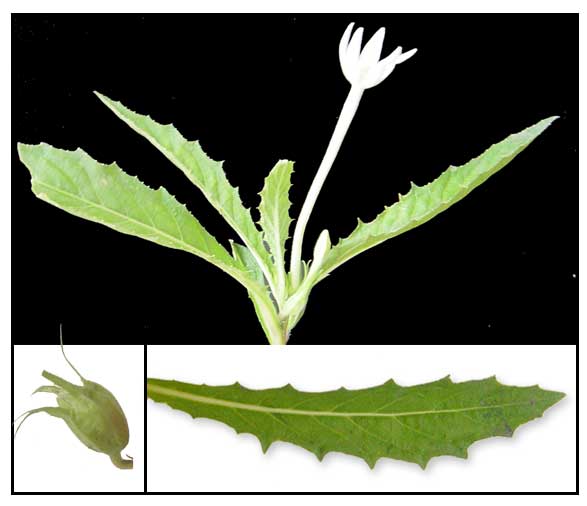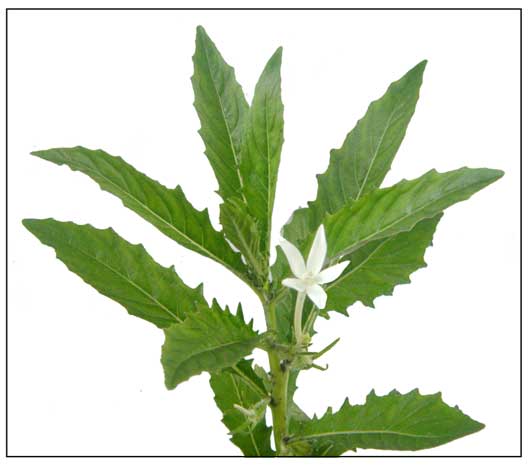| 
Gen info
- Hippobroma longiflora, called Star of Bethlehem or madam fate, is a flowering plant in the family Campanulaceae. It is the only species in the genus Hippobroma.
-
The Chinese name "ma zui cao" literally translates into "horse drunk grass," with the narrative of horses showing signs of drunkenness or madness after feeding on the plant. (13) (see toxicity below)
- The genus name Hippobroma means 'horse madness', relating to its toxic milky sap and toxin that drives horses insane. (21)
 Botany Botany
• Estrella is a low annual herb, erect,
spreading, branched or simple. smooth or slightly hairy, about 30 to 50
centimeters high. Leaves are alternate, soft, and counterbalance, with short stalks or without
stalks, 10 to 20 centimeters long, with serrate margins, narrow at both ends, pointed at the tip.
Flowers are fragrant, white, five-lobed and star-shaped, borne singly at the axis
of leaves. Calyx is green, 5-angled, and ovoid; tube is about 1 centimeter long. Five lobes are linear, inarticulate, about 1.5 centimeter long.
Corolla is white; tube is slender, 8 to 10 centimeters long; the lobes spreading, cancelate, and 2.5 centimeters long. Capsule is nodding, about 2 centimeters long, and slightly protruding from the calyx-tube.
• Stems: Erect, spreading, branched or simple, smooth or slightly hairy, 30-50 cm high. Leaves: Alternate, soft, and counterbalance, with short stalks or without stalks, 10 to 20 cm long, with serrate margins, narrow at both ends, pointed at the tip. Flowers: Fragrant, white, five-lobed and star-shaped, borne singly at the axis of leaves. Calyx is green, 5-angled, and ovoid; tube is about 1 cm long. Five lobes are linear, inarticulate, about 1.5 cm long. Corolla is white; tube is slender, 8 to 10 cm long; the lobes spreading, cancelate, and 2.5 cm long. Capsule is nodding, about 2 cm long, and slightly protruding from the calyx-tube. Fruits: Ellipsoid or obovoid bilicular capsules, villous, 1-1,5 cm long and 0,8-1,2 cm of diameter, containing several seeds almost ovoid 0,7 mm long, of pale brown color. (21)
Distribution
- Introduced, naturalized. (20)
- Throughout the Philippines. In damp places, along ditches and streams, against walls, low elevation. (20)
-
Cultivated in gardens.
- Found along drains, along rice paddies.
- Native to Jamaica.
 Constituents Constituents
• Plant yields alkaloid compounds: Oberlin, melamine and isotonic.
• Leaves contain alkaloid, poisoning, flavoring and proliferate.
• Minnesotan, an amorphous toxic alkaloid, can paralyze voluntary muscles,
that can affect the heart and respiration.
• Study of whole plant isolated three new triphenylphosphine alkaloids, hippodrome A (1), hippodrome B (2), and (-)-2',2"-triphenylphosphine (5), along with two known alkaloids, (-)-lobe-line (3) and (-)-cis-2',2"-diphenyllodelidiol (4). (see study below) (11)
- LC-MS/MS analysis resulted in 29 compounds, identified as phenolic, terpenoid, and alkaloid compounds groups: (-)-Gallocatechin-3-O-gallate (antioxidant, antiviral), cyclofenil diphenol (Alzheimer disease, cholinesterase inhibition), 2'.4'.6'.3.4-pentahydroxychalcone (antitumor), 2-aminophenol (antioxidant), 3-amino-1.2.4-triazole (carcinogenic), 3-aminopropionitrile (antiviral), 4-methylpyrazole (gastroprotection), acrylate (hemolytic, antibacterial), aminophylline, apiopaeonoside, chloratranol, cimetidine, creatinine, cytosine arabinoside, dihydrostreptomycin, fisetin, glabrol, glucuronate, hispaglabridin B, Homoeriodictyol, hypericin, isonicotinamide, lucidenic acid A, Man2XylManGlcNAc2, mefenamate, orcinol, peonidin 3-(6"-acetyl)glucoside, vindoline, lobeline A. (18)
- Study isolated four new alkaloids, hippobrines A-D (1-4), along with three new polyacetylenes, hippobrenes A-C. (see study below) (19)
- Phytochemical analysis of ethanolic extract of leaves yielded alkaloids, steroids, saponins, phenolics, flavonoids, with absence of triterpenoids.
(22)
- GCMS analysis of ethanol extract of leaves yielded compound 1-isobutyl-2,5-dimethyl-4-phenyl-piperidin-4-0-ol (37.77%) as most abundant, and 4-penten-1-oil, 5-phenyl-3-peridino (1.30%) as least abundant. Total phenolic, flavonoid, and HPLC results of quercetom were 139.21 ng GAE/g, 11.48 mg QE/g, and 0.009 mg/g respectively. (22)
Properties
• Juice is irritating to the eye and is known to cause blindness
in animals.
• A burning sensation in the mouth and throat results if the juice of any plant part is tasted.
• Considered anti-inflammatory, anti-neoplastic, analgesic and hemostatic.
• Studies have shown anti-inflammatory, antibacterial, tracheal smooth muscle relaxation, anti-conjunctivitis, antiangiogenesis, cataract progression inhibitory properties.
Toxicity concerns
• Note: There are various blogs written of its toxicity, mostly attributed to various alkaloids.
• It is notable for its concentrations of two pyridine alkaloids: lobeline and nicotine, with quite similar effects, psychoactive at small doses and more unpleasant effects at higher doses, including vomiting, muscle paralysis, and trembling.
(26)
• All parts of the plant poisonous, containing an acrid poison (lobelanidine) in the form of a white sap that produces a burning sensation in the mouth and throat and irritates the eyes, even causing blindness. Recommended to wear gloves when handling the plant. (24)
•
Contains a toxic alkaloid, isotomine that can cause muscle paralysis
and affect cardiorespiratory functions. Its dangerous properties limit its medicinal use.
• Used as a component in some hallucinogenic beverages and brews.
• Star of Bethlehem is highly toxic; its milky white sap from leaves and stems causes skin contact risks, including immediate vomiting and muscle paralysis in small doses. High doses lead to trembling, and eye contact can result in blindness. Ingestion may be fatal. Use gloves when handling and avoid cultivation due to its toxicity. (25)
Parts utilized
Leaves, flowers, roots.
Uses
Folkloric
- The Agusan Manobo use H. longiflora (elepanteng puti) used decoction of leaves for asthma, nervous breakdown, bronchitis and fever 1-3 times daily as needed; pounded leaves chewed or applied to toothache; decoction of leave used on cut and wounds.
(16)
-
Counterirritant for aching teeth: leaves are washed, pounded and put on painful carious teeth.
- In the Yucatan used for wounds and treatment of venereal disease, asthma, bronchitis,
epilepsy.
- Decoction of leaves used to wash wounds.
- Leaves and flowers are considered antipyretic and decongestant.
- Used for gaseous distention and diarrhea.
- Although known for its poisonous nature, it is sometimes used is small
amounts as a tonic for colds.
- In other folk medicinal systems, decoction of leaves used for asthma, bronchitis, cancer.
- Poultice of leaves applied to wounds and wrapped.
- In Indonesia, used for treatment of wounds and eye disorders. (4) In East Kalamintan, Indonesia, Kutain community use the plant for kidney stones and to increase stamina and vitality. (12)
- For cataracts, leaves pressed in water, and solution used as eye drops.
- In Nicaragua, leaves, roots and whole plant preparations used internally and externally for snake bites. (14)
- Infusion of kitolod leaves used for treatment of conjunctivitis (S. aureus). (17)
- Used as eye medicine to reduce cataracts.
Others
- An ingredient of cimora (Trichocereus pachanoi, Neoraimondia macrostibas, Iresine Isotoma longiflora Pedilanthus tithymaloides, and one of the Daturas) a hallucinogenic brew of the Peruvian Andes. (9)
Studies
• Seed Oils:
In a study of 12 seed oils from 10 plants families, nine are reported
to be medicinal. The major seed oil component of Isotoma longiflora
was oleic acid.
• Anti-Inflammatory / Leaves: Study of ethanol extract of sapu jagad (Isotoma longiflora) leaves showed anti-inflammatory effects using a paw edema method in male mice. Indomethacin was used as standard drug. (4)
• Alkaloids:Study of Lobelia siphilitica and Hypobroma longiflora isolated two new alkaloids: (S)-2-[(2S,6R)-1-methyl-6-(2-oxo-2-phenylethyl)piperidin-2-yl]-1-phenylethyl acetate and 6-[(E)-2-(3-methoxyphenyl)ethenyl]-2,3,4,5-tetrahydropyridine, together with -lobe-line, (1S,1′S)-2,2′-[(2R,6S)-1-methylpiperidine-2,6-diyl]bis(1-phenylethanol), and lobetyolin.
(5)
• -Lobe-line: -lobe-line is a natural alkaloid found in Indian tobacco (Lobelia inflata), Devil's tobacco (L. tupa), Cardinal flower (L. cardinalis), Great lobelia (L. siphilitica) and Hippobroma longiflora. Study showed Cmax and AUC0-6h were both linearly related to dose, with an absolute bioavailability of 13.8%. (6)
• Antibacterial: Study evaluated the antibacterial activity of kendali leaves extract against growth of Streptococcus mutans. Results showed the antibacterial activity of kendali leaves, with a smallest effective concentration of 0,001%. (8)
• Lobeline / Treatment of Asthma and Respiratory Illness: The active component of Lobelia is the alkaloid lobeline, a lipophilic molecule reported to act as both agonist and antagonist to beta nicotinic receptors. The highest amount of lobeline is found in the seeds. Studies suggest a potential as alternative treatment for patients with asthma and a promising complementary therapy for the management of respiratory disorders. It is often used in synergistic herbal formula, which includes Lobelia herb and seed, Zingiber officinale (ginger) and Hyssopus officinalis (hyssop). It should not be used as a substitute for drug therapy during an asthma attack, and is contraindicated during pregnancy. (10)
• Diphenethylpiperidine Alkaloids / Tracheal Smooth Muscle Relaxation Activity: Study of whole plant isolated three new diphenethylpiperidine alkaloids, hippofoline A (1), hippofoline B (2), and (-)-2',2"-diphenyllobelidiol (5), along with two known alkaloids, (-)-lobeline (3) and (-)-cis-2',2"-diphenyllodelidiol (4). Alkaloids 2 and 4 induced concentration-dependent relaxation effects on rat isolated tracheal rings that were precontracted with carbachol. (11)
• Potency of Kitolod Leaves for Conjunctivitis / Review: Kitolod leaves (H. longiflora) have been traditionally used to treat conjunctivitis.
Leaves contain flavonoids, alkaloids, and saponins, which can inhibit S. aureus growth as the main cause of
conjunctivitis. The antibacterial mechanism of these bioactive substances are via inhibition of nucleic acid synthesis, disruption of cytoplasmic membrane function, and inhibition of energy formation process. Various invitro studies have shown kitolod leaves inhibit the grown of S. aureus.
A study has shown an ethanolic extract of kitolod leaves inhibited S. aureus and S. typhi at concentration of 75% with diameter range f 11.3 - 12.16 mm. Further studies are suggested for standardization of extract and to evaluate clinical efficacy and safety. (17)
• Antiangiogenesis / Alkaloids and Polyacetylenes: Study isolated four new alkaloids, hippobrines A-D (1-4), along with three new polyacetylenes, hippobrenes A-C. All compounds (1-7) exhibited weak antiangiogenic activity against human endothelial progenitor cells, with IC50s ranging from 21.1 to 44.0 µg/mL. (19)
• Natural Inhibitor of Cataract Progression / Leaves: The H. longiflora plant has been empirically widely used to treat various eye diseases including cataract. The plant has high antioxidant activity attributed to its high phenolic and flavonoid content. Flavonoids are high-grade antioxidants that can capture free radicals such as anion superoxide and hydroxyl free radicals. Flavonoids can stimulate formation of endogenous antioxidants such as SOD, CAT, and GPx, blocking propagation reactions and capturing ROS, thus reducing risk of oxidative stress in cells. Results suggest the potential of the ethanol extract of leaves as a cataract inhibitor via its antioxidant property. (22)
• Endophytic Fungi as Source of Antioxidant: Study screened and identified an antioxidant-producing endophytic fungi from leaves of Hippobroma longiflora. Study evaluated the antioxidant activity of ethyl acetate extracts (AOL1-AOL6) of 6 endophytic fungi isolated from H. longiflora. While all the extracts showed antioxidant activity, AOL1 isolate showed very strong activity with IC50 of 28.50 µg/mL. Based on phenotypic and molecular identification AOL1 identified as Phyllosticta sp, which produce alkaloid, flavonoid, and terpenoid. (23)
Availability
- Wildcrafted.
- Seeds in the cybermarket. |



 Botany
Botany


